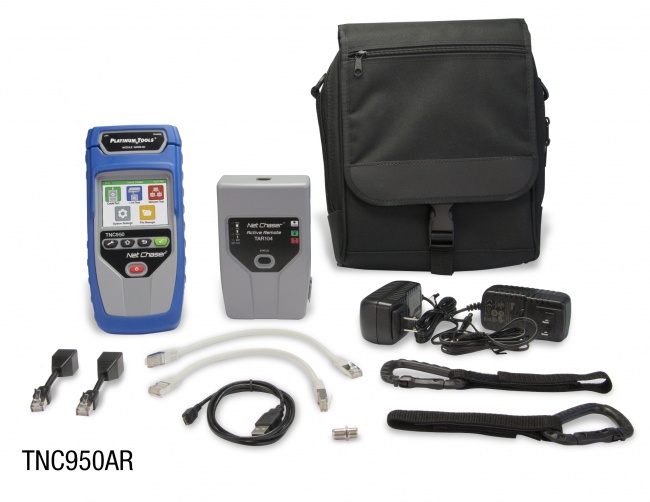| |
|
| |
Q. What’s the difference between the Net Chaser and T3 Innovations’ Net Prowler? |
| |
A. The Net Chaser is a Speed Certification device that performs wiremap test, measures cable length, peforms a Bit Error Rate Test, Signal to Noise Ratio, and SKEW test to ensure that your cable will perform to it’s maximum speed rating up to 1 Gigabit per secod. The Net Prowler is designed to verify proper connectivity and distance to short. The Net Chaser and Net Prowler both have advanced active networking features. View the comparison chart here.
|
| |
|
| |
Q. Does the Net Chaser require annual calibration? |
| |
A. No, the Net Chaser does not require annual calibration by the factory.
|
| |
|
| |
Q. What are the 1 inch RJ45 dongles in the Net Chaser Kit? |
| |
A. These are the RJ45 sacrificial cables (CA014). They are to be plugged into the Net Chaser and the Active Remote during testing to prolong the life of the Net Chaser and Active Remote RJ45 jacks.
|
| |
|
| |
Q. Why does the Net Chaser display the cable length in red and fail the cable test? |
| |
A. The Net Chaser tests to TIA568 A and B interconnect specifications. If your cable exeeds 328ft/100m, the Net Chaser will not perform the speed certification test and fail the cable length.
|
| |
|
| |
Q. What is a .TST file? |
| |
A. The .tst files consist of cable tests that have been performed in each file. This file also contains cable types and capacitance values (pF/ft) created by the user.
|
| |
|
| |
Q. Whats is pF/ft? |
| |
A. pF/ft stands for “Picofarad per foot”. It is the capacitance length measurement value used by the Net Chaser to measure a cable. The Net Chaser also uses TDR when a short is detected to measure the distance to the short.
|
| |
|
| |
Q. Whats the difference between the Link Test and Network Test menu? |
| |
A. The Link Test menu identifies port services such as link speed (Port Discovery), PoE, and port location options such as tone generation and link light flashing. The Network Test menu network features include ping, VLAN detectionn, Traceroute, LLDP/CDP, and DHCP.
|
| |
|
| |
Q. Can I update the Net Chaser Firmware? |
| |
A. Yes, just register your Net Chaser to access updates.
|
| |
|
| |
Q. Why can’t I get DHCP results in the Link Test or Network Test menus? |
| |
A. There may be a few of reasons why the Net Chaser cannot obtain DHCP. Make sure that use DHCP and Use DHCP DNS are selected in the settings menu, perform a VLAN test and make sure you are not connected to a tagged VLAN port. If you still do cannot get a DHCP, check to make sure the cable is connected to an active port.
|
| |
|
| |
Q. Does the Net Chaser detect PoE? |
| |
A. Yes, The Net Chaser detects PoE and PoE plus, PoE mode, and min/max voltages.
|
| |
|
| |
Q. How do you test an Ethernet cable via Ethernet wall plate/server/router ports? |
| |
A. The 12inch Ethernet Patch Cable (CA016) allows you to connect to an RJ45 plug to test a shielded or non-shielded Ethernet cable.
|
| |
|
| |
Q. How do I test unterminated Ethernet cables? |
| |
A. The 8-way Alligator Clip Cord Set (CA015) allows you to test unterminated Ethernet cable. This unique cord set has an RJ45 plug on one end and an alligator clip connected to each wire on the other end. This accessory allows you to make sure cables have not been damaged before you spend the time and money to terminate them.
|
| |
|
| |
Q. How do I extend the life of my RJ45 Jack? |
| |
A. The Sacrificial RJ45 Cable (CA014) extends the life of the RJ45 jacks on your tester and remote(s). Plug the sacrificial cable into the tester or remote and then plug the cables to be tested into the sacrificial cables. Continue testing cables with the sacrificial cables plugged into the tester or remote(s). If the sacrificial cables become worn or damaged, simply replace them. This prevents downtime and saves money by not having to send your tester in for an RJ45 jack replacement.
|
| |
|
| |
Q. How do I test cables with BNC connectors? |
| |
A. The F-jack to BNC jack allows you to easily test coax cables that have been terminated with BNC connectors.
|
| |
|
| |
Q. Can I purchase additional active remotes? |
| |
A. Yes, the Net Chaser Active Remote AR104 has selectable ID's (1-4) so users can have up to 4 remotes with different ID#s. |
| |
|
| |
Q. What is SKEW? Does my cable have a good SKEW result? |
| |
A. The Net Chaser measures signal delay between the pairs. This is referred to as SKEW. When Ethernet cable has excessive SKEW, networking devices may receive data packets in the wrong order, causing the network to slow down or have issues. While the IEEE802.3 specification has a maximum SKEW tolerance of 45ms, we fail at 35ms to ensure the cable’s reliability. Any measurement from 0-35ms will be reliable for Gigabit Ethernet transmission. The longer the cable is or the lesser quality cable, the SKEW measurement will increase. |
